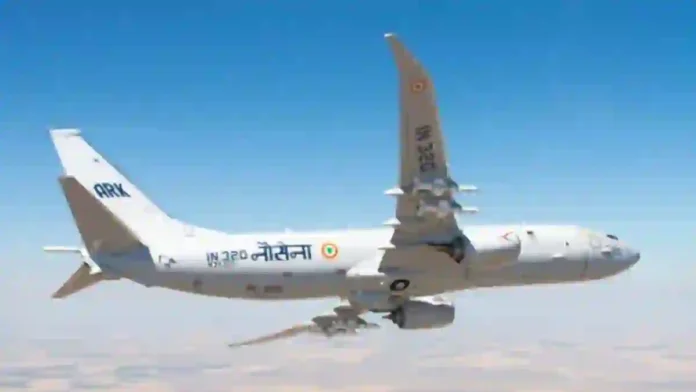The upcoming visit of a high-level US delegation to India between September 16 and 19 marks an important development in the trajectory of Indo-US defence and diplomatic relations. The core agenda of the visit is to conduct negotiations on a proposed $4 billion deal for the sale of six additional Boeing P-8I Poseidon maritime patrol aircraft to the Indian Navy, signalling the continuity of strategic defence cooperation despite ongoing trade disputes and policy frictions between New Delhi and Washington.
The delegation will comprise senior officials from the US Department of Defence, Boeing, the Defence Security Cooperation Agency (DSCA), the Navy International Programs Office (NIPO), and the Program Office PMA-290 that oversees maritime patrol aircraft acquisition and sustainment.
Read- Roadmap of Milestones And Phases – Testing, Prototype Deliveries, Production And AMCA Integration
Their visit underscores the importance placed by the US on sustaining institutional military-to-military links with India at a time when broader trade ties have faced turbulence following Washington’s imposition of punitive tariffs on Indian goods in response to New Delhi’s Russian oil imports.
The prospective deal aligns with India’s operational priorities, as the Navy already operates a fleet of 12 P-8I aircraft deployed between Arakkonam and Goa. Acquired in two tranches in 2009 and 2016, the P-8Is have proven their capabilities in anti-submarine warfare, anti-surface operations, and long-range intelligence, surveillance, and reconnaissance (ISR) roles, including during critical stand-offs with China in Doklam and Ladakh.
Their interoperability has also been tested and enhanced through joint patrols and exercises with Quad members such as Australia, further embedding the aircraft into India’s maritime security framework.
Given these operational advantages, the induction of six more P-8Is is viewed as a continuation of a capability that has already demonstrated strategic utility, especially in strengthening maritime domain awareness in the Indian Ocean Region (IOR) at a time of rising Chinese naval presence.
The timing of the delegation’s visit also carries significant diplomatic weight. Bilateral ties had recently entered one of their most strained phases in two decades, owing to the Trump administration’s sharp criticism of Indian defence purchases from Russia and the imposition of steep tariffs.
Read- Trump Tariffs Threaten To ‘Destroy’ 25 Years of US-India Partnership, Warn Former Diplomats
Read- Navy Outlays Its Plans To Expand The Fleet To Over 200 Warships And Submarines By 2035
However, signals of rapprochement have emerged, highlighted by recent exchanges between Prime Minister Narendra Modi and President Trump as well as the renewed focus on concluding trade negotiations.
Against this backdrop, US officials appear keen to reinforce defence collaboration as a stabilising anchor for the broader relationship, especially given New Delhi’s sustained emphasis that procurements from both the US and Russia are governed by national security imperatives rather than alignment politics.
Institutional frameworks of cooperation remain robust despite the trade skirmishes. India, designated by Washington as a “Major Defence Partner” in 2016, already enjoys licence-free access to advanced US technologies, while foundational agreements such as LEMOA, COMCASA, and ISA have bolstered operational and industrial convergence.
Moreover, regular dialogues under mechanisms like the Defence Policy Group and the 2+2 ministerial have continued in parallel, even at the height of tariff tensions.
Recent visits by US defence and foreign policy officials, including Andrew Byers and Alka Patel, further reflect a continuous strategic dialogue that extends beyond aircraft sales to cover cyber cooperation, reciprocal defence procurement, and emerging domains like artificial intelligence.
Read- DRDO And SAFRAN Combine To Give India Its First Jet Engine With 100% ToT
The geopolitical environment also frames the urgency of these engagements. Modi’s recent appearance alongside President Xi Jinping and President Vladimir Putin at the Shanghai Cooperation Organisation summit underscored India’s balancing act between competing partnerships.
The US, conscious of retaining its foothold in India’s defence ecosystem in competition with Russia’s still-dominant share of approximately 60% of India’s military inventory, is using this deal as a way to consolidate defence-industrial influence.
Over the past two decades, India has already contracted nearly $24 billion of American-origin platforms, from transport aircraft like the C-130J and C-17 to frontline systems including Apaches, Chinooks, M777 Howitzers, Harpoon missiles, and MQ-9B armed drones.
The P-8I thus fits seamlessly into this evolving portfolio of acquisitions, unlike other offerings from Washington such as the F-35, which are seen as mismatched with India’s immediate operational requirements.
For India, the negotiation is also about striking a balance between asserting strategic autonomy and deepening partnerships that support its long-term military modernisation. The P-8I deal neatly complements the Navy’s pressing need for enhanced ISR and anti-submarine warfare reach as Chinese submarine forays in the IOR multiply.
At the same time, New Delhi remains firm on the legitimacy of its Russian defence and energy procurements, viewing them as critical to maintaining strategic depth. Thus, defence procurements from the US are not a matter of supplanting Russia but of diversifying sources to align with operational gaps and ensuring robustness against external shocks.
The likely conclusion of the additional P-8I deal will signal the consolidation of maritime security cooperation, offer confidence-building momentum to bilateral relations in a period of strain, and reaffirm the defence partnership as one of the key pillars of the Indo-US relationship.
By focusing on deals that build on existing operational synergies, both sides can separate tactical trade differences from longer-term strategic convergences.
The forthcoming visit of the US delegation, therefore, is not just about six aircraft, but about a continued commitment to joint capacity-building, stability in the Indian Ocean, and the broader architecture of a rules-based Indo-Pacific.
Based On Hindustan Times Report
Agency




